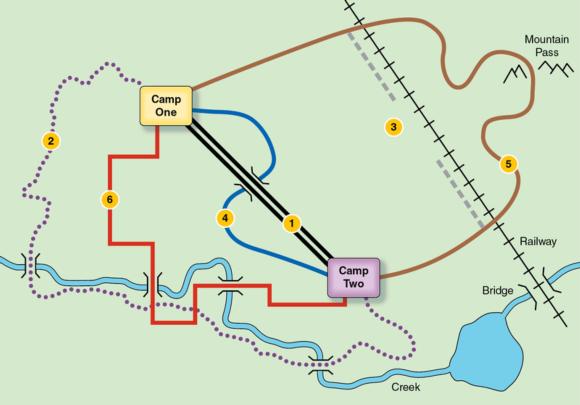Qualitative Modifications
This is an excerpt from Effective Leadership in Adventure Programming 3rd Edition Ebook With Field Handbook by Simon Priest & Michael Gass.
Are you overwhelmed with the amount of numbers in the weighting and choosing phases? In this next example, we have used a qualitative method of weighting that is easier for leaders who are not mathematically inclined or are unable to juggle and balance several numbers in their heads.
You can't break every decision down into quantifiable probabilities. In fact, you will be able to deal with the majority of decisions by effectively considering the qualities of the information you gather for any option. Picture yourself as a bicycle trip leader with a choice of six different routes to take between campsites as mapped in figure 14.4. Driving to the next campsite or staying put are two other options available to you. The problem facing you is how to best balance existing risks with biking pleasure.

Figure 14.4 Representative map of the six bike routes.
By interpreting the map and using judgment, you should gather the facts and assumptions about the six routes. Route 1 (shortest distance) is a straight line along a major divided highway with a very high volume of traffic, no shoulder, and gentle grades. Route 2 (longest distance) follows and crosses a creek on a scenic winding route on hard-packed paths along old railway grades. Route 3 (moderate distance) has light traffic on a hilly, gravel back road, part of which follows a flat railway cut with a section of road missing, and your judgment guesses that walking the bikes along the side of the tracks might be possible. Route 4 (short) follows minor highways with heavy traffic and parallels the major highway and cuts underneath it at one point. Route 5 (long) duplicates route 3 except that it crosses the railway instead of following it and climbs over a steep mountain pass with nice views on dirt back roads. Route 6 (moderate) rambles along paved farm roads with moderate traffic, crossing the same scenic creek as route 2 but by a less direct route of straight segments and right-angled turns. Remember, you also could just drive to the next campsite or hang around the same campsite all day.
Because you are seeking a balance of risk management and enjoyment, during weeding out, you should probably drop the two options of driving to the campsite or staying put for the day. Certainly, driving or hanging around doesn't let anyone enjoy bicycling. Once you have weeded out the superfluous options, the six routes remain. This is a large number to subject to the next step, but you could reduce it by applying additional criteria, such as avoiding vehicle fumes or hills and seeking paved surfaces or scenery.
Organizing the six remaining routes into a qualitative comparison table, as done in figure 14.5, replaces the quantitative decision tree. This is a simple way to compare the pros and cons of the available options. For the six options, we list qualities worth considering in order of importance and then show sample responses.

Figure 14.5 Comparative tabulated summary of the six bike routes.
Qualities are typically organized around the three themes of positive, such as alternatives, benefits, contingencies, and points of interest; neutral, such as costs, distances, terrain, road type, and surface; and negative, such as traffic and other dangers, concerns, and possible consequences. You don't have to include all themes in such a comparative table, but to be the most effective, you should consider all the available information and evaluation criteria. For example, alternatives and contingencies are often overlooked variables to any consequences that might result if you select an option and put it into action. You should take into account any contingency plan that might make an option more desirable and prepare an alternative plan in case the option you select falls short of expectations.
When following a qualitative approach to weighting the content of these tables, you may prefer to avoid numerical quantities. While the mathematical leader might correctly state that negatives are half the concern, positives a third, and neutrals the remaining sixth (or a similar weighting), this approach is not qualitative. Instead, you may mentally cross out the entries that are equivalent options, recognizing that entries higher on the list carry more weight in the decision. It requires sound judgment to estimate or predict equivalence.
For example, you can view entire options and entries between options or within the same option as "six of one and half a dozen of another." Exposure to extreme traffic for the shortest distance without a shoulder on route 1 may be equivalent to a short distance of exposure to heavy traffic with an underpass to negotiate on route 4. In another light, the bridge crossings on routes 2 and 4 may equal the railway walk on route 3. For route 5, the extra energy expended for the hill climb may be worth the nice views.
For the purpose of choosing, identifying equal entries removes many of the more moderate qualities. Those few extremes that remain may allow the best option to stand out. Thus, once you have accounted for equivalencies using judgment, the reduced entries permit you to more effectively choose the option that has the strongest chance of success.
Learn more about Effective Leadership in Adventure Programming, Third Edition, With Field Handbook.
More Excerpts From Effective Leadership in Adventure Programming 3rd Edition Ebook With Field HandbookSHOP

Get the latest insights with regular newsletters, plus periodic product information and special insider offers.
JOIN NOW


